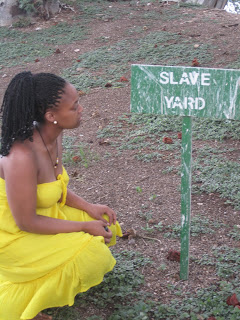














I was presented the opportunity to experience something that very few people have ever experienced. I am sure that everyone knows who Kunta Kinteh is, and if you do not, it is vital that you find out. I traveled to Juffureh in The Gambia to visit two historic sites: The Roots Heritage Trail and Kunta Kinteh Island (James Island). After missing two ferries, I finally caught the third one across the Atlantic Ocean to reach Juffereh. It was a gruesome experience, but I did it. I arrived at the Heritage Trial to see a big “THE ROOTS” sign, which let me know that I was there. This trail is the very same trail that Africans traveled down when they were captured. They were forced down the trail, taken to the slave trading post, when it was time; they were forced out on a boat and taken to James Island (Kunta Kinteh Island). This island sits in the middle of the Atlantic Ocean by itself, the only way to get to and from the island is by boat; it is too far from land to swim and the water is extremely deep. This is why they call this island the point of no return, because when the slaves were brought here, they were stuck there and chained. One thing that caught my eye was that there were cannons on the land by the dock where they loaded the slaves into the boat, and there were also cannons on Kunta Kinteh Island. The Europeans would shoot the cannons if a slave would try to escape from the Island. With that being said, I walked down the trail, and about half way down, the bottom fell out of the sky, and I was soaked. Because this was a trail in the woods near swamps, I began to get really dirty and muddy but that did not make me stop. I continued to travel down the trail until I reached the remains of the holding house for the slaves. This was where they kept the slaves that they captured, until it was time for them to be transported to James Island. After traveling the trail I ran into about six small children. It had been raining and they were soaked, so I knew that they had been outside during the rain, which is not uncommon in Africa. Many of them did not have on any clothes but underwear, even the little girls. They were so excited to see someone, so I asked them if they wanted to take a picture with me. They all ran up to me with so much joy in their eyes. Afterwards, I took a canoe across the Atlantic Ocean to Kunta Kinteh Island; I was very nervous traveling such a distance in such deep water. When I reached the Island, I was very emotional because I was traveling the same pathway that my ancestors traveled; this was absolute hell for them. The difference is, my pathway was voluntarily and they were forced and beat. This island was the point at which they knew they would never see Africa again. I explored the island; there were remains of “The Governors room”, “The Slave Yard”, and “The Council’s Room”. I will say that this was a wonderful experience, very emotional, but it was very necessary for me as an African American woman.

No comments:
Post a Comment